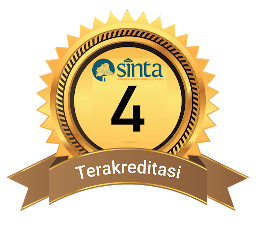Developmment of 3D Pageflip Professional Based Digital Pocket Book as A Practical and Attractive Learning Media on The Material of Reaction Rate
DOI:
10.29303/cep.v7i2.3081Published:
2024-12-04Issue:
Vol. 7 No. 2 (2024): Edisi NovemberKeywords:
Research and development, Learning media, Digital pocketbook, Reaction rateArticles
Downloads
How to Cite
Abstract
This developmental research aims to develop learning media as a digital pocketbook based on 3D Pageflip Professional on the valid Reaction Rate material. This type of research is research and development (R&D) with the ADDIE development model, which includes analysis, design, development, implementation, and evaluation. This research was carried out only until the development stage. The data analysis technique used in this study is descriptive statistics, namely by calculating the percentage of validation values. The data obtained came from validators consisting of 3 expert lecturers, respondents consisting of 2 chemistry teachers and 30 students from two high schools, SMA Negeri 4 and SMA Negeri 5 Pekanbaru. The results showed that the development of learning media in the form of a digital pocketbook on the Reaction Rate material was declared valid to meet the aspects of substance content, learning design, display (visual communication), software utilization with percentages of 90%, 98.21%, 93,75% respectively, 94.44%.. the overall average score of digital pocketbook validation is 94.1%. The results of the trial of user responses with teachers and students to digital pocketbooks showed that the reaction rates were 96.32% and 86.61%, respectively, with practical criteria by teacher respondents and interesting criteria by students.
References
Ahmadiyah, A., Hairida, H., & Lestari, I. (2020). Pengembangan Buku Saku Digital Berbasis SETS pada Materi Reaksi Reduksi Oksidasi. EduChem, 1(1).
Akbar, S. D. (2013). Instrumen perangkat pembelajaran.
Damayanti, D., Jalaludin, J., & Zulyanty, M. (2018). Pengembangan Buku Saku Berbasis Problem Based Learning Untuk Pembelajaran Matematika di Sekolah Menengah Pertama Negeri 13 Kota Jambi (Doctoral dissertation, UIN Sulthan Thaha Saifuddin Jambi).
Dari, R. W., Purwaningsih, S., & Darmaji, D. (2021). Pengembangan Penuntun Praktikum Fisika SMA/MA Berbasis KPS menggunakan 3D Pageflip Professional pada Materi Pengukuran. Edumaspul Jurnal pendidikan, 51, 230-241.
Deka, H. (2023). Pengembangan Modul Digital Berbasis Multiple Intellegence Menggunakan 3d Pageflip Professional Pada Pembelajaran Fisika SMA (Doctoral dissertation, UIN RADEN INTAN LAMPUNG).
Hertina, D., Nurhidaya, M., Gaspersz, V., Nainggolan, E. T. A., Rosmiati, R., Sanulita, H., ... & Ferdinan, F. (2024). Metode Pembelajaran Inovatif Era Digital: Teori dan Penerapan. PT. Green Pustaka Indonesia.
Khoironi, R. (2016). Pengembangan Pocket Book Of Chemistry On Android (Pockemon) Untuk Mata Pelajaran Kimia Materi Kelarutan dan Hasil Kali Kelarutan (Skripsi). Universitas Negeri Semarang, Indonesia.
Kurnia, T. D., Lati, C., Fauziah, H., & Trihanton, A. (2019, October). Model addie untuk pengembangan bahan ajar berbasis kemampuan pemecahan masalah berbantuan 3d pageflip. In Prosiding Seminar Nasional Pendidikan Matematika (SNPM) (Vol. 1, No. 1, pp. 516-525).
Kurniati, P., Kelmaskouw, A. L., Deing, A., Bonin, B., & Haryanto, B. A. (2022). Model proses inovasi kurikulum merdeka implikasinya bagi siswa dan guru abad 21. Jurnal Citizenship Virtues, 2(2), 408-423.
Loupatty, F. J. I. (2022). Strategi komunikasi di masa pandemi Covid-19 dengan menggunakan komunikasi non-verbal. Jurnal Ilmiah Komunikasi Makna, 10(1), 1-16.
Rahmawati, N. L., Sudarmin, S., & Pukan, K. K. (2013). Pengembangan buku saku ipa terpadu bilingual dengan tema bahan kimia dalam kehidupan sebagai bahan ajar di MTs. Unnes Science Education Journal, 2(1).
Riduwan, K. (2012). Metode & Teknik Menyusun Proposal Penelitian. Bandung: Mandar Maju.
Saka, M. R. G. (2019). Pengembangan Media Pembelajaran Audio Visual Berbasis Literasi Sains dengan Menggunakan Software Camtasia Studio (Doctoral dissertation, UIN Raden Intan Lampung).
Sari, N. P., Suhirman, S., & Walid, A. (2020). Pengembangan modul pembelajaran IPA berbasis etnosains materi interaksi makhluk hidup dengan lingkungannya untuk menanamkan jiwa konservasi siswa kelas VII SMP. Bio-Edu: Jurnal Pendidikan Biologi, 5(2), 62-73.
Sole, F. B., & Anggraeni, D. M. (2018). Inovasi pembelajaran elektronik dan tantangan guru abad 21. Jurnal Penelitian Dan Pengkajian Ilmu Pendidikan: E-Saintika, 2(1), 10-18.
Wijaya, E. Y., Sudjimat, D. A., & Nyoto, A. (2016, September). Transformasi pendidikan abad 21 sebagai tuntutan pengembangan sumber daya manusia di era global. In Prosiding Seminar Nasional Pendidikan Matematika (Vol. 1, No. 26, pp. 263-278).
Author Biographies
Gita Geniati Saragih, Universitas Riau
Rasmiwetti Rasmiwetti, Universitas Riau
Jimmi Copriady, Universitas Riau
License
Copyright (c) 2024 Gita Geniati Saragih

This work is licensed under a Creative Commons Attribution-ShareAlike 4.0 International License.
Authors who publish with Chemistry Education Practice agree to the following terms:
- Authors retain copyright and grant the journal right of first publication with the work simultaneously licensed under a Creative Commons Attribution License 4.0 International License (CC-BY-SA License). This license allows authors to use all articles, data sets, graphics, and appendices in data mining applications, search engines, web sites, blogs, and other platforms by providing an appropriate reference. The journal allows the author(s) to hold the copyright without restrictions and will retain publishing rights without restrictions.
- Authors are able to enter into separate, additional contractual arrangements for the non-exclusive distribution of the journal's published version of the work (e.g., post it to an institutional repository or publish it in a book), with an acknowledgement of its initial publication in Chemistry Education Practice.
- Authors are permitted and encouraged to post their work online (e.g., in institutional repositories or on their website) prior to and during the submission process, as it can lead to productive exchanges, as well as earlier and greater citation of published work (See The Effect of Open Access).






